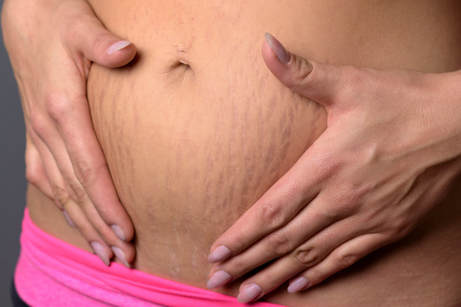 Stretch Marks are Not Ugly! Don’t Be Ashamed of them Stretch Marks are Not Ugly! Don’t Be Ashamed of them Skin, the largest organ in the human body, works like a flexible rubber band. It stretches and adjusts matching to the growing body needs but can be damaged if it is stretched beyond its capability too quickly (just like how your rubber band breaks) causing stretch marks. In fact, between 50 and 90 percent of women bear stretch marks according to a study from the University of Michigan Health System. Gone are the days when mommies took pride in their stretch marks! Mommies today take pride in climbing the ladder of success at work through their ultimate efforts along with their responsibilities of child rearing and family commitments. Some regard these marks as a symbol of motherhood, some are extremely self-conscious about its presence and try to veil it over and few others are double-minded, they do feel embarrassed but also want to take it in their stride! Which of these categories do you belong to? The Name Speaks for Itself Women and pregnancy are all that get associated with stretch marks. But it can affect men, teenagers or any person of any age. There is no clue why these marks affect some people and leave the rest unaffected. But there is a journal study that suggests that women who get pregnant at a younger age are more prone to stretch marks and so do women who put on excess weight during pregnancy. As the name suggests, a stretch mark is a type of scar that develops when our skin stretches or shrinks quickly. To understand how these marks make themselves visible, it becomes necessary to become aware of the skin layers in our body. The epidermis forms the outermost layer of the skin below which exists the dermis. Dermis is composed of connective tissue and provides elasticity and strength to the skin with the help of collagen, the main structural protein of the connective tissue. Elastin is another protein of the connective tissue that supports many tissues in the body to resume their shape after stretching or contracting. During periods of rapid growth in the body, the skin stretches abruptly which damages the collagen and elastin and ruptures them. When the skin stops expanding (that is, growth stops gradually), the epidermis appears wrinkled and stretched as the collagen beneath it is damaged and not available for support. Causes Puberty, pregnancy, rapid weight gain or increased muscle mass are some examples of rapid growth phases during which these marks begin to appear. Save yourself from excess weight gain during pregnancy by meeting a registered dietitian nutritionist at www.firsteatright.com who can suggest a healthy diet and lifestyle plan to keep you and your fetus healthy. Certain people get affected by stretch marks after using creams containing steroids in them and these marks also make their presence felt in people with Cushing’s disease (excess weight gain is a critical symptom) and Marfan syndrome (a condition that affects connective tissues). Even having a family history of stretch marks puts you at a greater risk. Most stretch marks appear discolored initially or sometimes with a red, purple, pink, reddish-brown or brown tinge depending on your skin color. They might itch and also have a distinct texture that is different from the surrounding skin. These marks start diminishing in course of time but never do they disappear totally in most people. Treatment Stretch marks are not painful but it makes some individuals lose their self-confidence and might even seem disfiguring rarely. Due to these mental effects, there have been numerous research carried out for years together to find a remedy for these marks. But none of them provide 100% results but the different ways provide us interesting clues on reducing these marks as much as possible. There are home remedies as well as clinical treatment procedures available for treating stretch marks. Clinical Treatment Procedures Various studies prove two ingredients to be useful for treatment-hyaluronic acid and tretinoin. Tretinoin is a type of retinoid that helps early stretch marks to fade and this is backed up by strong study results. Dermatologists also make use of the following procedures to make stretch marks less visible, but they do not completely leave them untraceable.
Home Remedies There are multiple home remedies prescribed for stretch marks but there are no valid proofs supporting their success. Some of the common treatments prescribed include: Gels, lotions and creams: Individuals might see effective results when they apply any of these continuously daily for several weeks as soon as they find stretch marks appearing. But, dermatological associations don’t back up these and neither are there supportive proofs stating their success rate. Using a moisturizer on the damp skin soon after bathing can help keep the skin soft and supple. Pregnant women often find the skin on their belly itch prominently and using a moisturizer provides relief to some extent. Applying Oils: Many people suggest massaging cocoa butter, almond oil, olive oil or vitamin E oil to diminish stretch marks. Research proves that none of these products aided in fading stretch marks. But none of these are dangerous too and people might sometimes benefit from using them. Sunscreens: While sunscreen lotions don’t improve stretch marks, they help to improve skin’s health and appearance. Sunlight exposure makes these scars more noticeable and also makes the person more prone to stretch marks as sun exposure can break down collagen. But before trying any of these remedies, pregnant women are advised to speak to their doctor regarding its safety as some of these products might contain ingredients such as retinol that can harm the fetus. Also, while some people advocate tanning as a remedy, in fact it makes the marks even more visible. But there are limited evidences that prove that products containing hyaluronic acid or the herb centella can help to prevent stretch marks. Trying these treatment options is not wrong but don’t remain stubborn and determined to get rid of stretch marks at the risk of your health. Learn to love your natural body! Then, you would start realizing its beauty. Comments are closed.
|
AVOID FRAUD. EAT SMART.+91 7846 800 800
AuthorDietitian & Nutritionist Dr. Nafeesa Imteyaz. Archives
July 2024
Categories
All
Dr. Nafeesa's Blog @blogspot |
- Home
- Written Testimonials
- Consult
- Clinics
- Blogs
-
Diet & Nutrition
- Diabetes Reversal
- IVF IUI not needed for PCOS PCOD Infertility
-
Medical Nutrition
>
-
Disease & Conditions
>
- Infertility | PCOS
- Diabetes Mellitus
- Cholesterol
- Hypothyroid
- Kidney Problems
- Hypertension
- Cardiovascular Diseases
- Liver Diseases
- Gastro intestinal disorder
- Cancer
- Metabolic Disorders
- Orthopedic Disorders
- Eating Disorders
- Dietary Recall
- Weight Record Filled By Clients
- Online Payment Transaction Details
- Online Clients Weight Check Form
- Our Program Package Service Charges
- Weight Record 2017 Clients
- Measurements sent by Clients
- Terms & Conditions Of Payment
- Thanks. Your Form is Submitted
- Video Testimonials
- Lifestyle & Wellness
- Lifestyle & Wellness Blog
- Allergy & Intolerance
- Weight Loss / Gain
- Weight Loss / Slimming Blog
-
Disease & Conditions
>
- Life Cycle Nutrition >
- Sports Nutrition >
- Integrity in Nutrition
- Knowledge Centre
© COPYRIGHT 2022. ALL RIGHTS RESERVED. FRST HEALTHCARE PVT LTD.
Dr. Nafeesa Imteyaz of First Eat Right clinic, is the Best Dietitian Nutritionist in Bangalore. Best Dietitian Nutritionist in Pune. Best Dietitian Nutritionist in Hyderabad. Best Dietitian Nutritionist in Chennai. Best Dietitian Nutritionist in Mumbai. Best Dietitian Nutritionist in Delhi. Best Dietitian Nutritionist in Kolkata.


